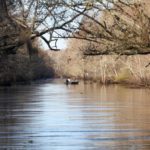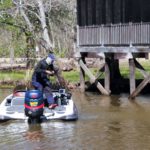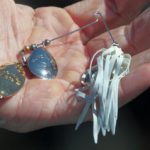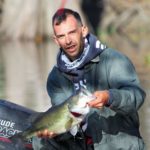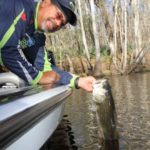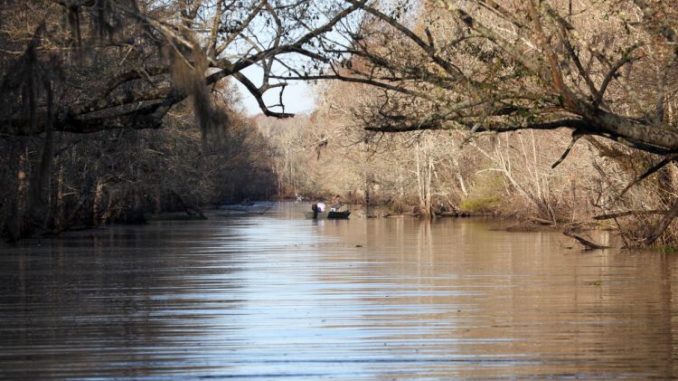
Local stick shares hot spots for success
Lake Fausse Pointe is a 17,000-acre system located in Iberia and St. Martin Parishes. Contiguous to the Atchafalaya Basin, the lake is essentially a catch basin for northern runoff and as a result is somewhat shallow when compared to public systems north of Interstate 10. But, that shouldn’t prohibit bass anglers from keying in on and fishing this particular lake for largemouth bass.
Cody Pattillo is someone who knows Lake Fausse Pointe and fishes it regularly when he’s not climbing utility poles for CLECO as a lineman. Growing up in Loreauville, his father would bring him and his younger brother to the lake on weekends. And, it was during those informative years that Pattillo learned the region.
“I was a never a big saltwater fishing guy,” Pattillo said. “I liked being in the woods with the cypress trees and swamp. I just loved it. Over the years I wanted to become a better bass fisherman and learn new tactics, so I joined a couple of bass clubs and started competing in the local hog fight tournaments. In fact, the first tournament I ever fished was a hog fight on Lake Fausse Pointe and I wound up winning it, catching three fish that weighed something like 7 pounds.”
Jody David, Louisiana Department of Wildlife and Fisheries District 6 Biologist Manager says Lake Fausse Pointe is a location the department has been stocking for quite some time.
“It’s a place where we’ve put quite a few Florida fingerlings every couple of years, but you don’t have a high percentage of them like we do in other places we’ve stocked,” he said. “And, even though Lake Fausse Pointe is silted in places, they’re really starting to catch some nice fish — especially during the spring.”
Catching some nice fish became quite apparent when Pattillio and I made a trip to Lake Fausse Pointe and started the morning trolling a canal off the main lake locals refer to as the Dogleg. We weren’t the first boat in the canal that morning and actually spotted three others ahead of us working the banks. Additionally, we were fighting a windy high pressure system that appeared to have caused the bass to come down with a case of lockjaw.
Nonetheless, we pressed on knowing it was just a matter of time before we’d get our bites. Suddenly, the water exploded beneath the bow of one of the boats just ahead of us. The angler was having quite a tussle and we got a ringside seat to the show.
When New Iberia angler Dustin Dore, finally got his fish safely in his boat, he asked us if we happened to have a scale he could borrow to weigh the catch. Pattillo graciously helped him out and the big largemouth weighed a hefty 5 pounds 13 ounces. In fact, it was one of three 5 pound plus fish we saw caught that morning — one of them by a friend of Pattillo’s who came along with us in his own boat.
According to David, Florida genetics have been dropped in several of the lakes in his district. Spring Bayou, Chicot Lake and Lake Fausse Pointe are three he mentions receiving their fair share of Florida fingerlings over the years.
During 1999, 2006, and 2007, electrofishing samples of largemouth bass were taken from Lake Fausse Pointe testing the impact of the stocking. By collecting liver tissues to perform genetic analysis on, biologists were able to confirm that Florida largemouth bass had in fact influenced native bass populations. In 2007, samples indicated 12 percent of the fish were either pure mature Florida species or Louisiana native/Florida hybrid strain largemouth bass.
Over the years the Lake Fausse Pointe fishery has only gotten better as a result of the LDWF stocking program. What’s more, it appears the biggest hindrance to a really productive fishery in this region is tropical events that have caused fish kills David says.
“Environmental-wise, we’ve been lucky the last few years,” said David. “Anytime we have tropical storms that tend to flip the bottom of our lakes and backwater swamps over, depleting the oxygen. We haven’t had that in a while and in general we’ve had some good success throughout Louisiana when it comes to the largemouth bass spawn. It shows not only in our test sampling, but in the fishing surveys we do, because fishermen are catching lots of largemouth bass — big largemouth bass.”
One of the things anglers will notice right away when coming to Lake Fausse Pointe is the lake has a stained cocoa color due to the northerly runoff it receives each spring and early summer. The water is also slightly cooler due to the runoff. Canals tend to have somewhat clearer water, but by contrast have slightly warmer temperature.
According to Pattillo, when you get a north wind the lake drains towards Bayou Teche and the water pulls out of the canals and into the lake. As a result, pretty-colored water, as Pattillo refers to it, drains out of the woods into the canals and with it comes baitfish that bass and sac-a-lait gobble up.
The forage Pattillo tries to mimic is shad and therefore his fishing rods are loaded with baits that are white in color.
Pattillo said, “The lake is always so full of shad. I use white buzzbaits, white crankbaits, and white spinnerbaits. Anything that’s white, bass seem to like. But, it’s either white or red actually. White looks like shad and red looks like crawfish. You’re trying to offer them something they might be eating. A lot of times in the spring, you might have a bunch of shad in the back of canals. After the month of May, as you get into June the water heats up and you normally have to get out of the canals by the middle of the day. Then you’ll want to hit the cypress trees in the main lake where they’ve got a little current and the bait is more active.”
During the summer months, Pattillo says that because anglers coming to Lake Fausse Pointe will be fishing the main lake, you need to move around a bit more in order to find clear water. Additionally, Pattillo mentions where you find clear water and floating vegetation during the summer pattern you’ll also be apt to find bass in groups.
“In the dead heat of summer the main thing is to go find a patch of cypress trees and some pretty green water with some flow through it and start chunking a spinnerbait. In the main lake, the water is cooler and there’s a lot of oxygen,” he says. “Sooner or later you’ll run into them. And, when you do, they’ll generally be all piled up together.”
There is an increasing number of tournaments being held in and around Lake Fausse Pointe with large payouts, where size does matter.
Size-wise, Pattillo said, “Though it’s rare, every now and then you hear of an 8 pounder being caught. But last year I caught a 7 pounder and a few 6s. I also know a lot of other guys who caught quite a few 6s. I’d have to say the average ‘big’ bass on the lake is going to run 6 to 6-½ pounds. But, if you’re a competition bass fisherman, you can expect to sometimes catch a springtime 5 fish stringer that weighs 15 pounds. In the summer in the main lake around the cypress trees you might catch a 13 to 14-pound stringer.”
One of Pattillo’s friends and co-workers at CLECO is Gerald Foulcard. Foulcard lives in Patterson, just down the road about an hour’s drive from St. Martinville. What’s more, Lake Fausse Point is one of the locations his bass club holds tournaments. Because the water is somewhat stained, Foulcard says one of the ways he overcomes the condition is using big-bladed spinnerbaits.
“Sometimes bigger is better,” Foulcard explained. “One of the reasons I like big baits is they provide a larger profile in the muddy water. Fish not only see the bait, but they also feel it, which could result in a strike. But, you have to be a line watcher, because with a bigger bait you can get bumped and not know it,”
During our trip, Foulcard had a 5-pound, 4-ounce bass smash his large-bladed spinnerbait, proving his technique and theory works.
Foulcard recommends using buzzbaits and Ribbit frogs during summer morning sessions if there’s clear water. And, when the morning bite slows, he favors an 8-inch Zoom Lizard in june bug or watermelon red colors.
Pattillo showed us around the lake during our outing and passed by the Lake Fausse Pointe State Park campground, where anglers can take advantage of the cover fishing around the cabins and boat wharfs. It was here we watched the third 5-plus pound bass caught that morning, when Johnny Maynor, from Lafayette pulled in his 5-pound, 8-ounce bass out from under one of the cabins.
Maynor was scouting for a tournament and wanted to take advantage of the cover the cabins offered. After weighing the big largemouth, Maynor released it and mentioned that’s where we’d find him fishing come next tournament on the lake.
Other spots on Fausse Pointe where anglers can catch largemouths are the Texaco Oilfield canals, barrow pits along the levee, Coon Slough and Sandy Cove around duck blinds, if there is enough water to get in the cove.
Although Pattillo and I didn’t land any lunker bass of our own, those we caught and released would have at least allowed us to put a few pounds on the scale had we been competing.
Lake Fausse Pointe will never get the accolades of Toledo Bend when it comes to double-digit jumbo bass. But, for a small coastal body of water, size still matters. What’s more, when sizing up the lake on a whole, it has plenty of 5s and 6s that will put a 5-fish tournament stringer in the money. If you don’t believe it, just ask Pattillo.
Recommended stay
One of the best places to stay while fishing Lake Fausse Pointe is Lake Fausse Pointe State Park. The park has 18 deluxe, 2-bedroom waterfront cabins that sleep up to 8 people per cabin. Cabins come complete with fully equipped kitchens, boat docks, screened in porches and air conditioning.
